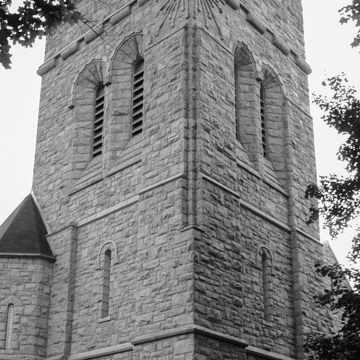Wellsboro's first house of worship was a hewn-log meetinghouse built by Benjamin Wistar Morris for fellow Quakers. By the 1830s Wistar and his wife were dead, the meetinghouse was rotting, and local Quakers were drifting toward the Episcopal faith. On calling a Philadelphian from a New York seminary, St. Paul's was organized in 1838, making it Wellsboro's oldest surviving congregation. The Romanesque Revival building is the work of Wood, whose designs often bordered on the bizarre, here evidenced in the blast of light across the tower that referenced St. Paul's conversion but could also be taken for an octopus climbing out of the belfry. A turret adds to the mix of massive random rock-faced Antrim stone walls while forming a transition from the gabled vestibule and nave to the rather blunt tower. Wood was an accomplished church architect whose designs were sought by congregations (Episcopalians in particular) from Kansas City to Anniston, Alabama. St. Paul's was one of his last designs; he died the year that work on it began. John L. Robinson was one of the church's organizers and his son Jesse was one of the largest contributors to the 1890s building fund.
You are here
St. Paul's Episcopal Church
If SAH Archipedia has been useful to you, please consider supporting it.
SAH Archipedia tells the story of the United States through its buildings, landscapes, and cities. This freely available resource empowers the public with authoritative knowledge that deepens their understanding and appreciation of the built environment. But the Society of Architectural Historians, which created SAH Archipedia with University of Virginia Press, needs your support to maintain the high-caliber research, writing, photography, cartography, editing, design, and programming that make SAH Archipedia a trusted online resource available to all who value the history of place, heritage tourism, and learning.














